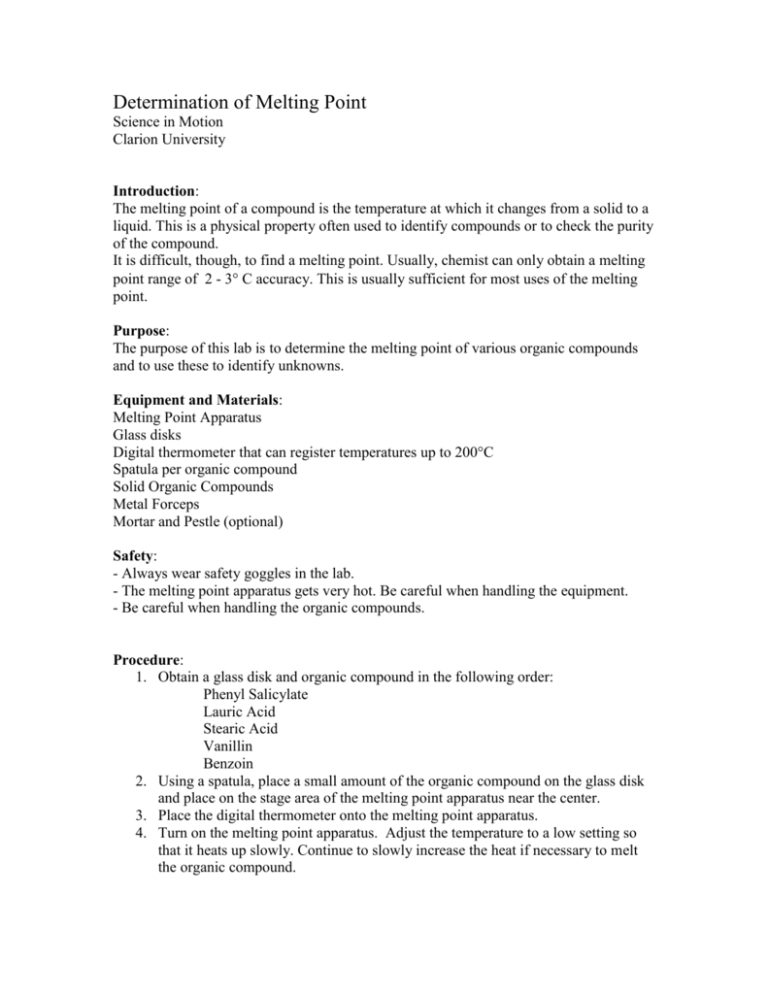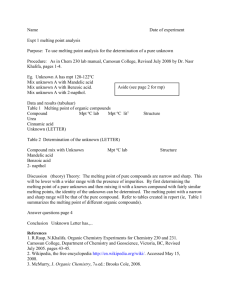Determination of Melting Point
advertisement

Determination of Melting Point Science in Motion Clarion University Introduction: The melting point of a compound is the temperature at which it changes from a solid to a liquid. This is a physical property often used to identify compounds or to check the purity of the compound. It is difficult, though, to find a melting point. Usually, chemist can only obtain a melting point range of 2 - 3 C accuracy. This is usually sufficient for most uses of the melting point. Purpose: The purpose of this lab is to determine the melting point of various organic compounds and to use these to identify unknowns. Equipment and Materials: Melting Point Apparatus Glass disks Digital thermometer that can register temperatures up to 200°C Spatula per organic compound Solid Organic Compounds Metal Forceps Mortar and Pestle (optional) Safety: - Always wear safety goggles in the lab. - The melting point apparatus gets very hot. Be careful when handling the equipment. - Be careful when handling the organic compounds. Procedure: 1. Obtain a glass disk and organic compound in the following order: Phenyl Salicylate Lauric Acid Stearic Acid Vanillin Benzoin 2. Using a spatula, place a small amount of the organic compound on the glass disk and place on the stage area of the melting point apparatus near the center. 3. Place the digital thermometer onto the melting point apparatus. 4. Turn on the melting point apparatus. Adjust the temperature to a low setting so that it heats up slowly. Continue to slowly increase the heat if necessary to melt the organic compound. 5. Observe the organic compound and note the temperature at which the compound begins to melt. Also observe when the substance has completely melted. 6. Record your data in table #1. 7. Complete procedure 1 – 6, until you have completed all the organic compounds your instructor has provided. 8. Obtain unknown samples, and determine its melting point range. Record your results in data table #2. 9. Identify the unknown by comparing the melting point range with the ranges found in data table #1. Record your results in data table #3. Data Table #1: Organic Compounds and Melting Point Ranges Organic Compound Melting Point Range in C Data Table #2: Unknown Organic Compound and Melting Point Range Unknown Sample Melting Point Range in C Data Table #3: Identification of Unknown Samples Unknown Sample Organic Compound Questions: 1. Define the “melting point” of a substance. 2. What is the purpose of determining melting points? 3. Why is the method not used for finding the melting points of inorganic compounds? 4. Why could the rate of heating influence the melting point? Determination of Melting Point Teacher’s Notes Continues Organic Compound Phenyl Salicylate Lauric Acid Stearic Acid Vanillin Benzoin Sodium citrate dyhydrate Unknowns: 1.___________________ 2.___________________ 3.___________________ 4.___________________ Melting Point Range in C 41 - 43 44 68-69.5 81-85 137 150







